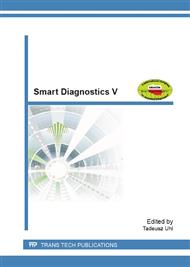p.84
p.91
p.101
p.109
p.117
p.127
p.134
p.140
p.149
Energy Diagnosis of the Structure of the Demolition Hammer with WoSSo Vibroisolation of a Biomechanical System
Abstract:
The article presents the results of energy diagnosis of the structure of an innovative, mechanized, hand-held demolition tool with application of the Constant Interaction Force Vibroisolation (abbreviated as WoSSO) of a biomechanical system. Sample results refer to the demolition hammer of the weight of 15,6 kg and the frequency of working shocks of 20 Hz. The diagnostic research was to recognise and evaluate the energy and spatial impact of the innovative structure of the hammer provided with anti-vibration system upon human. 3D energy physical and mathematical models of the entire system human demolition hammer with vibroisolation of 18 degrees of freedom were designed and the problem was solved with the digital simulation method. The forces enforcing three directions of vibrations were identified via experiments at the research stand on the model base compliant with the ISO standard and then entered in the simulation program. The obtained results of the energy diagnosis of the structure explained the phenomenon of the energy flow in the examined biomechanical system and confirmed the efficiency of the flow reduction of the energy of vibrations into the human body at all the reduction points in the three directions of vibrations.
Info:
Periodical:
Pages:
117-126
Citation:
Online since:
October 2013
Authors:
Price:
Сopyright:
© 2014 Trans Tech Publications Ltd. All Rights Reserved
Share:
Citation:


